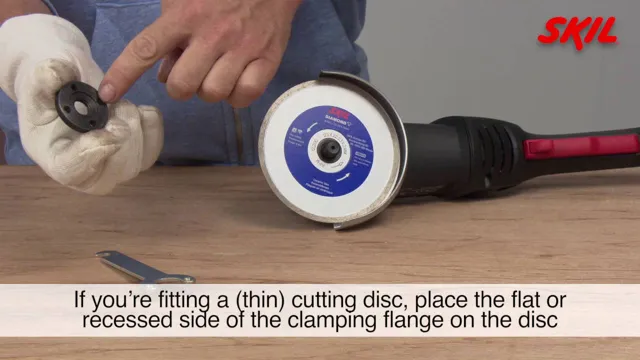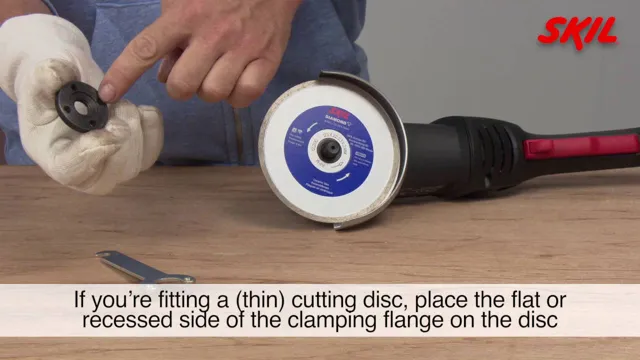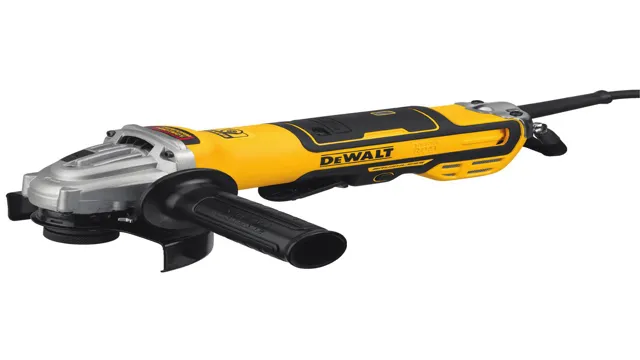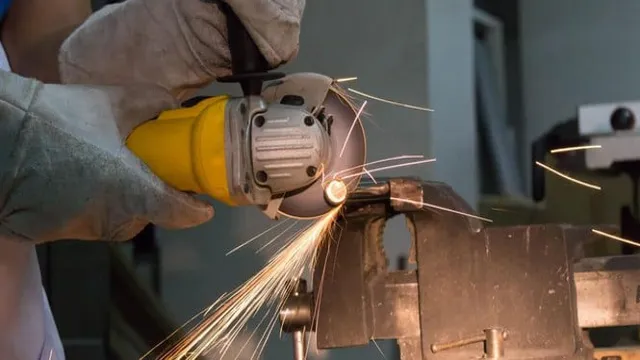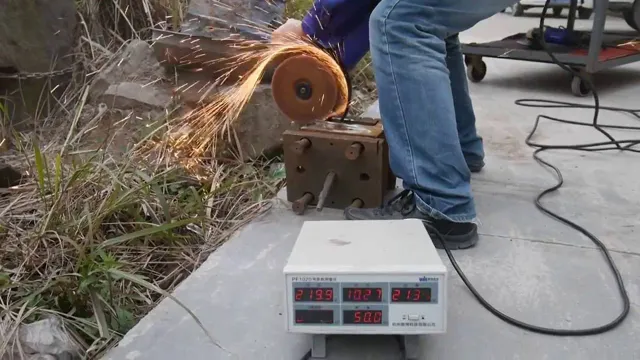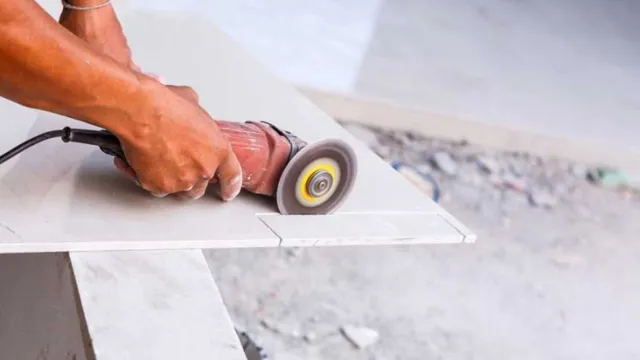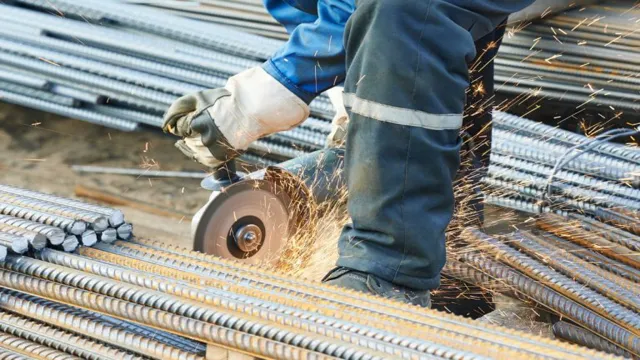What Angle Grinder Blade to Cut Concrete? Tips and Tricks for Efficient Cutting
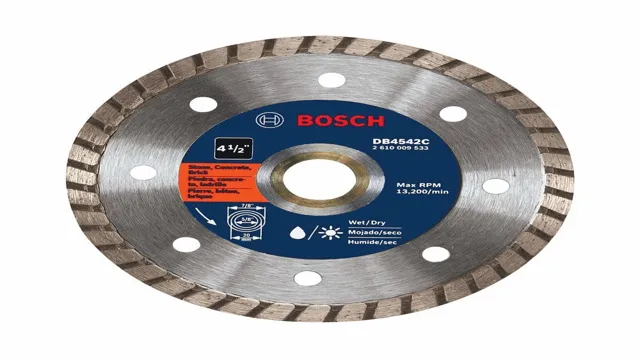
Looking to cut concrete with an angle grinder? You’ll need a specialized blade to do so effectively. But with so many options available, choosing the right one can be daunting. Should you go for a diamond blade or a carbide-tipped one? How thick should it be? These are just a few of the questions that can make the selection process overwhelming.
Don’t worry though, we’ve got you covered. In this guide, we’ll take a closer look at how to choose an angle grinder blade for cutting concrete. By the end of it, you’ll have a clearer idea of what to look for and what to avoid.
So let’s dive in!
Understanding Concrete Cutting
When it comes to cutting concrete, using an angle grinder can be a great option. But what angle grinder blade should you use? The answer depends on what type of concrete you’re cutting and how thick it is. For thinner slabs, a diamond blade will work well.
These blades have small diamond particles embedded in them that make them extremely durable and able to grind through tough materials like concrete. However, for thicker slabs, you’ll need a more heavy-duty blade. Look for a turbo rim blade, which has a serrated edge and can cut through thicker concrete with ease.
No matter what blade you choose, always wear eye protection and a dust mask to keep yourself safe while working with concrete.
Types of Concrete
Concrete cutting is a process of cutting or drilling through concrete. There are various types of concrete, each with different strengths and uses. One of the most commonly used types is reinforced concrete, used in building construction and designed for maximum strength and durability.
Another type is decorative concrete, which is used for aesthetic purposes, such as on patios or walkways. Other types include precast concrete, used in commercial and industrial projects, and shotcrete, which is used for lining and coating walls. Understanding concrete cutting is essential for anyone working in construction or DIY projects.
A powerful concrete saw or drill is used to cut through concrete, with different blades or bits used for different types of concrete. The process requires a lot of skill and expertise to ensure accuracy and precision. Proper safety measures must be followed, as the process creates a lot of dust and noise.
Overall, concrete cutting is an important process in construction and renovation projects and must be done with care and attention to detail.
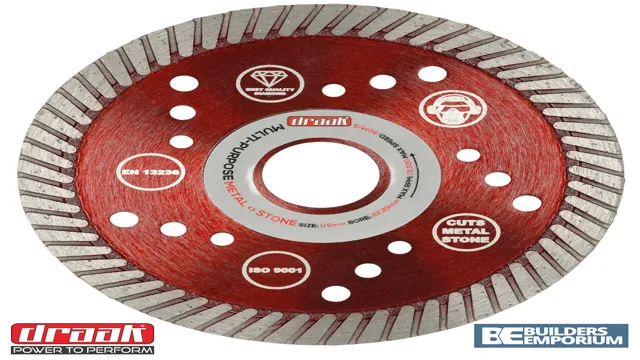
Factors Affecting Concrete Cutting
Concrete cutting is an essential process in the construction industry. This technique involves cutting through hard, solid concrete surfaces using specialized tools and equipment to accommodate pipes, cables, or make openings in walls. However, several factors can affect the success of concrete cutting, including the type of equipment used, the age and strength of the concrete, the thickness of the material, and the ambient temperature.
For instance, cutting thick concrete sections may require the use of a more potent cutting machine. Ageing concrete may be strong but brittle, leading to cracks and damages during the cutting process. High temperatures may also affect the rate of cutting, making it necessary to adjust the equipment’s speed to avoid overheating and failure.
Ultimately, understanding these factors is critical in ensuring the success of any concrete cutting project. Employing the right machinery and technique can not only save time and resources but also prevent damage to the underlying structure and avoid potential hazards.
Choosing the Right Angle Grinder Blade
If you need to cut through concrete using an angle grinder, there are several factors to consider when choosing the right blade. First and foremost, you want to select a blade that is specifically designed for concrete cutting. These blades typically have a diamond grit edge that can handle the tough and abrasive nature of concrete.
You’ll also want to consider the size of the blade, as larger blades can cut through thicker concrete at a faster rate. It’s also important to pay attention to the blade’s RPM rating, as using the wrong blade can be dangerous and result in accidents. Ultimately, by investing in a high-quality diamond blade that is appropriate for your specific job requirements, you can ensure a safe and efficient cutting process.
With the proper tools and technique, cutting concrete with an angle grinder can be a breeze.
Type of Blade
When it comes to choosing the right angle grinder blade, there are several factors to consider. The type of blade you select will depend largely on the task at hand. For example, if you’re working with metal, a metal-cutting blade will be your best bet.
On the other hand, if you’re working with masonry or concrete, a diamond blade will be necessary to get the job done. It’s also important to consider the size of the blade, as well as its thickness and teeth count. A thicker blade will last longer, but may not be ideal for intricate cuts.
Similarly, a blade with more teeth will yield a smoother cut, but may not be as efficient for heavy-duty work. Ultimately, understanding the type of blade that is right for your project is key to achieving the best results. So, take the time to do your research and choose wisely.
Size of Blade
When it comes to choosing the right angle grinder blade, size does matter. The size of the blade is determined by its diameter and thickness, and it impacts the depth and speed of your cuts. Generally, smaller blades are better suited for lighter tasks such as cutting tiles or small pieces of metal, whereas larger blades are more appropriate for heavy-duty cutting of thick metal or concrete.
It’s crucial to use the appropriate size for your project to ensure both efficiency and safety. If you use a blade that is too small, it may not be able to cut through the material effectively, which can lead to an increased risk of accidents. Conversely, if you use a blade that is too large, it may be difficult to maneuver, leading to poor accuracy and potentially damaging the material.
Therefore, it’s necessary to select the appropriate blade size depending on your application. With the right blade size, you can ensure efficient and precise cutting while minimizing any safety hazards.
Quality of Blade
When it comes to choosing the right angle grinder blade, quality is key. The quality of the blade will not only affect the overall performance and efficiency of the angle grinder but can also directly impact the safety of the user. A high-quality blade will be durable and able to withstand the high-speed rotation of the angle grinder, minimizing the risk of cracking or breaking during use.
It is essential to choose the right blade based on the material you intend to cut or grind. Different blades are designed for different purposes, and using the wrong blade can lead to damage or injury. For instance, a metal blade used on wood can quickly become dull, making it less efficient and potentially dangerous.
Therefore, it is crucial to take the time to research and select the appropriate blade for your specific needs. By choosing a high-quality, appropriate blade, you can ensure both efficient and safe operation of your angle grinder.
Safety Precautions Before Cutting Concrete
When it comes to cutting concrete with an angle grinder, safety should be the top priority. Before starting any work, it is important to wear protective gear such as safety glasses, hearing protection, and a dust mask to prevent injuries from flying debris and harmful dust. It is also important to choose the right blade for the task at hand.
When looking for what angle grinder blade to cut concrete, diamond blades are the best choice. These blades are designed to withstand the hardness of concrete and can cut through it with ease. It is also crucial to ensure that the blade is installed correctly and is in good condition with no signs of wear or damage.
Taking these precautions will significantly reduce the risk of accidents and ensure a successful concrete cutting job.
Wear Protective Gear
When it comes to cutting concrete, safety should always be your top priority. One crucial safety precaution before cutting concrete is to wear protective gear. Since cutting concrete exposes you to various hazards such as flying debris, dust, and loud noise, wearing the appropriate protective gear can prevent injuries.
Invest in a good quality pair of safety glasses, earplugs, respirator, and a hard hat to ensure maximum protection. Safety glasses will protect your eyes from any flying debris, while earplugs will protect your hearing from the loud noise produced during cutting. A respirator will protect your lungs from the dust particles that are generated during the cutting process, while a hard hat will protect your head against any falling debris.
In summary, wearing protective gear can help mitigate the risks associated with cutting concrete and ensure that you remain safe and healthy throughout the process.
Secure the Work Area
Cutting concrete can be a hazardous task, and safety precautions must be taken to ensure the work area is secured. Before starting, it’s essential to wear protective equipment such as goggles, gloves, and a dust mask to avoid inhaling harmful particles. Additionally, it’s crucial to clear the work area of any potential hazards such as debris, electrical wiring or other obstacles, to avoid tripping or falling during operation.
Keep in mind that concrete cutting generates a lot of dust, which can cause respiratory problems or eye irritation. Therefore, proper ventilation must be ensured by opening the windows, or using fans to allow fresh air circulation. It’s also important to keep a first aid kit near the work area in case of an emergency.
Overall, taking these necessary safety measures will help to prevent accidents and ensure a safe work environment while cutting concrete.
Cutting Concrete with an Angle Grinder
When it comes to cutting concrete, angle grinders are often the go-to tool. But what angle grinder blade should you use for this task? The answer is a diamond blade. These blades are specifically designed to cut through tough concrete surfaces, and they feature diamond chips embedded in the blade’s edge for added durability.
When selecting a diamond blade, it’s important to choose the right size and shape for your angle grinder setup. You’ll also want to consider the blade’s quality and price, as a higher-quality blade will last longer and cut more efficiently. With the right blade and technique, you can easily cut through concrete slabs, blocks, and walls using an angle grinder.
Just be sure to wear protective gear and follow safety guidelines to avoid accidents.
Step-by-Step Guide
Cutting concrete with an angle grinder can be a challenging task, but with the right tools and techniques, it can be done efficiently and effectively. The first step is to ensure that you have the appropriate safety gear, including goggles, gloves, earplugs, and dust mask. Next, select the appropriate blade for your angle grinder, choosing one that is specifically designed for cutting concrete.
Before starting, mark out the area you wish to cut and use a square to ensure that your lines are straight. When you are ready to commence cutting, start at the edge of the concrete and create a groove along your marked line. Use a back-and-forth motion with the angle grinder, keeping your cuts shallow and steady to prevent overheating the blade.
Progressively deepen your cuts until they reach the desired depth, and remember to frequently check on your blade to ensure that it is not overheating or becoming dulled. With the right technique and attention to detail, cutting concrete with an angle grinder can be a successful and rewarding process.
Tips for More Efficient Cutting
Cutting concrete with an angle grinder can be a daunting task, especially for beginners. However, it is an effective way to shape and cut concrete with a reasonable degree of precision. Firstly, it is important to choose the right type of blade.
For concrete, a diamond-tipped blade is most effective as it is designed specifically for the material. Secondly, before cutting, ensure that you are wearing protective gear such as safety glasses and gloves as there are particles and debris that could potentially cause harm. Lastly, it is important to take breaks periodically as using an angle grinder can be strenuous.
Give your arms, hands, and back a rest to prevent any potential injury. With these tips in mind, cutting concrete with an angle grinder can be a much safer and efficient process.
Conclusion
In conclusion, choosing the right angle grinder blade to cut concrete is an important task that shouldn’t be taken lightly. It’s important to consider factors such as the type of grinder you have, the thickness and hardness of the concrete, and the type of cut you need to make. Just like a surgeon needs the right tool to perform a delicate operation, a DIY’er needs the right blade to cut through their concrete with precision and ease.
So, remember to do your research and choose wisely- your concrete (and your fingers) will thank you for it!”
FAQs
What is the best type of angle grinder blade for cutting concrete?
The best type of angle grinder blade for cutting concrete is a diamond-tipped blade.
Can a regular angle grinder blade cut through concrete?
No, regular angle grinder blades are not strong enough to cut through concrete.
What size of angle grinder blade is suitable for cutting concrete?
A 7-inch or 9-inch angle grinder blade is suitable for cutting concrete.
How long does an angle grinder blade last when cutting concrete?
The lifespan of an angle grinder blade when cutting concrete depends on various factors such as the quality of the blade, the intensity of use, and the density of the concrete. However, on average, a diamond-tipped blade can last up to 50 hours of continuous use.
How do I choose the right angle grinder blade for cutting concrete?
To choose the right angle grinder blade for cutting concrete, look for blades that are labeled for concrete or masonry use. Also, consider the size of the blade and the diameter of your angle grinder.
Can angle grinder blades be used to cut through reinforced concrete?
Yes, angle grinder blades can be used to cut through reinforced concrete, but it will take longer and might cause more wear and tear on the blade.
What precautions should I take when using an angle grinder blade to cut concrete?
When using an angle grinder blade to cut concrete, wear protective gear such as gloves and goggles. Also, make sure the blade is properly attached to the grinder and use the appropriate blade for the task. Finally, be mindful of the blade’s wear and tear, and replace it when necessary.

